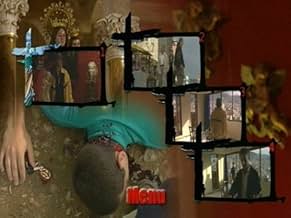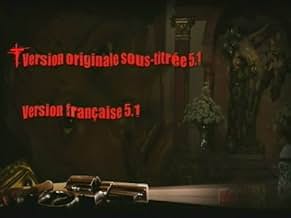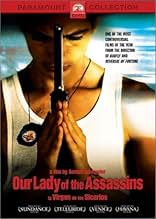CALIFICACIÓN DE IMDb
6.8/10
4.4 k
TU CALIFICACIÓN
El escritor F. Vallejo regresa a Medellín tras más de 30 años de ausencia. Conoce a Alexis, de 16 años. Alexis es el tipo de asesino que noquea a quien sea en cuanto se lo ordenan. Los dos s... Leer todoEl escritor F. Vallejo regresa a Medellín tras más de 30 años de ausencia. Conoce a Alexis, de 16 años. Alexis es el tipo de asesino que noquea a quien sea en cuanto se lo ordenan. Los dos se sienten mutualmente atraídos.El escritor F. Vallejo regresa a Medellín tras más de 30 años de ausencia. Conoce a Alexis, de 16 años. Alexis es el tipo de asesino que noquea a quien sea en cuanto se lo ordenan. Los dos se sienten mutualmente atraídos.
- Premios
- 3 premios ganados y 3 nominaciones en total
Opiniones destacadas
Hi, I was reading about the comments of the movie "La virgen de los sicarios"... some people think that there is bad acting in this movie, and i am disagree absolutely... I live in Cali, Colombia and i can assure you that what you see in the film is exactly what you can see in the real live in some poor parts of the colombian cities... i am talking about everything: the way people talk, the way they move, all is very real... if you live in this country, you can understand that the actors in the movie are not acting... they are living!!! because that what you see in the movie is what we are in Colombia. Thanks for your attention.
Occasionally venturing into dreamlike surrealism, the movie mostly hits you with a heavy dose of cinema verite. The movie is about the city of Medellin in the same way that Midnight Cowboy is about New York. The characters aren't dealing with the problem of staying human in a huge metropolis, but staying human in the midst of instability that verges on anarchy.
The effects of fifty years of civil war aggravated by narcotrafficking and the associated crime are shown in two ways, which are the central themes of the film: the shift from the old and traditional to the modern, and the loss of value that human life has suffered. The banality of the several killings in the movie drives home the second, and the explorations that Fernando and his two boyfriends (sequential, not simultaneous) take through the city show the first.
The movie is violent like the Godfather is violent: the killings are not gratuitous, they are there to make a point. As a document of life in an industrial Andean city which just happens to be the second city of the country poised to become the next Vietnam, or better said, the next El Salvador, La virgen de los sicarios is excellent. It is sophisticated in its writing and its photography. The characters are human and complex. It ought to be in far wider release than just one screen in the whole L.A. area - which happens to be on the West Side, where Spanish-speaking people typically don't live.
The effects of fifty years of civil war aggravated by narcotrafficking and the associated crime are shown in two ways, which are the central themes of the film: the shift from the old and traditional to the modern, and the loss of value that human life has suffered. The banality of the several killings in the movie drives home the second, and the explorations that Fernando and his two boyfriends (sequential, not simultaneous) take through the city show the first.
The movie is violent like the Godfather is violent: the killings are not gratuitous, they are there to make a point. As a document of life in an industrial Andean city which just happens to be the second city of the country poised to become the next Vietnam, or better said, the next El Salvador, La virgen de los sicarios is excellent. It is sophisticated in its writing and its photography. The characters are human and complex. It ought to be in far wider release than just one screen in the whole L.A. area - which happens to be on the West Side, where Spanish-speaking people typically don't live.
Our Lady of The Assassins will have you either loving it or hating it. It polarizes because it never compels as a movie itself, but is laid out before each person, needing him or her to internalize the film. The movie speaks of living in a Columbian drug town and the irony as people get shot everyday by moral-less teens set against the beautiful city and sky. But the main character, an old gay writer, is never engaging or as articulate and thoughtful as one would expect from the "best known grammarian" from Columbia. In fact, as grammar is rigidly structured, so are the writer's banal comments about 'time being what you want it to be' and 'life only being lived to die.' The musings have been heard before, but with greater clarity and depth. There is no epiphany to be associated with any of his sayings. However, he meets a young former gang member, marked for death, named Alexis and they fall in love. The film is so detached that their love is the closest element to emotion, and still one cannot understand why this boy would sleep with a man who incessantly whines constantly. The shocking life in Medellin is the most compelling aspect of the movie and the movie still has points, it's just that they are not nearly poignant enough. They are shown by the director, but never cohesively placed into an argument. I really wished I could have liked this movie.
Prepared as we are for the image of Columbia that CNN shoves down our throats- full of Narcos, Paracos and desperate politicians-, there is no way to predict the surreal way of life the characters in this movie pass through. This is a film that penetrates into a very real Medellin, where nothing is certain and everything is so vulnerable that human life seems to exist only the instant in which it takes place. Medellin is like Fernando- the main character-, it is like his way of walking through a church in the feverishly catholic ambient of Latin America with his sixteen year old murderer lover- who is actually more like an angel fallen from grace. Alexis- the young shooter- is the result of a less than miserable way of life, where poverty and violence rape viciously at each other, almost to a point of neutralization, what seems perverse is in the end the most innocent. This film is strong and profound, it should be forced on all news spokesmen with Colombian corpses in the background: `Lady this is Medellin, not Switzerland'.
Medellin is a dangerous city in more ways than one is lead to believe. At the time of the action, Pablo Escobar's empire has been dismantled and his loyal soldiers are scattered all around the city engaging in a game of death, revenge and petty vendettas. There is no reverence for life in a place that has seen violence on a daily basis and where children have access to guns for protection in order to survive in that environment.
Barbet Schroeder, the German director, expands on Fernando Vallejo's novel, which the author adapted for the screen, resulting in a highly violent and bloody film that is disturbing, as well as true.
Fernando, the older gay man who comes back to his native city of Medellin, quickly finds a boy to satisfy his needs. Alexis, the young man, is seen at first at the all-male brothel where he is offered by the pimp to Fernando. Alexis turns out to be something the older man didn't expect. This is a boy that is savvy in the ways of how to survive in the city, who clearly takes an interest in the older, and richer Fernando.
Alexis is a marked man and it's only a matter of time; his days are numbered because there are other youths behind him that will do whatever in their power to eliminate him. Fernando can't believe what his city has become, but he has no desire to go away again. When Alexis is killed, Fernando mourns his death until Wilmar, another young gay man appears in his orbit. Little prepares Fernando to realize who Wilmar is really.
Fernando's comments on the situation in his city, as well as in the Colombian reality, are the basic themes of the film. While one side of him cries for that old place he knew as a child, he welcomes this new metropolis full of danger and people that attracts and repulses him at the same time.
German Jaramillo appears to be the alter ego for the writer, Fernando Vallejo, whose story seems to resemble that of the Fernando in the novel and in the film. Mr. Jaramillo's take on Fernando keeps him away from the confrontations between his young lovers and what he thinks is right. He never passes judgment on what the young people are doing, yet he is instrumental for providing the bullets that Alexis needs to defend himself. The other two young actors, Anderson Ballesteros and Juan Diego Restrepo, play Alexis and Wilmar respectively.
Barbet Schroeder has directed the film with all its realism showing us a society in which all hope seems to have abandoned the citizens of the city.
Barbet Schroeder, the German director, expands on Fernando Vallejo's novel, which the author adapted for the screen, resulting in a highly violent and bloody film that is disturbing, as well as true.
Fernando, the older gay man who comes back to his native city of Medellin, quickly finds a boy to satisfy his needs. Alexis, the young man, is seen at first at the all-male brothel where he is offered by the pimp to Fernando. Alexis turns out to be something the older man didn't expect. This is a boy that is savvy in the ways of how to survive in the city, who clearly takes an interest in the older, and richer Fernando.
Alexis is a marked man and it's only a matter of time; his days are numbered because there are other youths behind him that will do whatever in their power to eliminate him. Fernando can't believe what his city has become, but he has no desire to go away again. When Alexis is killed, Fernando mourns his death until Wilmar, another young gay man appears in his orbit. Little prepares Fernando to realize who Wilmar is really.
Fernando's comments on the situation in his city, as well as in the Colombian reality, are the basic themes of the film. While one side of him cries for that old place he knew as a child, he welcomes this new metropolis full of danger and people that attracts and repulses him at the same time.
German Jaramillo appears to be the alter ego for the writer, Fernando Vallejo, whose story seems to resemble that of the Fernando in the novel and in the film. Mr. Jaramillo's take on Fernando keeps him away from the confrontations between his young lovers and what he thinks is right. He never passes judgment on what the young people are doing, yet he is instrumental for providing the bullets that Alexis needs to defend himself. The other two young actors, Anderson Ballesteros and Juan Diego Restrepo, play Alexis and Wilmar respectively.
Barbet Schroeder has directed the film with all its realism showing us a society in which all hope seems to have abandoned the citizens of the city.
¿Sabías que…?
- TriviaGiven the fact that Anderson Ballesteros did a great job portraying a tough hitman with street knowledge, all the roles he got later were pretty much the same, for example, playing as Pablo Escobar's main hitman on "El Patrón del Mal"
Selecciones populares
Inicia sesión para calificar y agrega a la lista de videos para obtener recomendaciones personalizadas
- How long is Our Lady of the Assassins?Con tecnología de Alexa
Detalles
- Fecha de lanzamiento
- Países de origen
- Sitio oficial
- Idiomas
- También se conoce como
- Our Lady of the Assassins
- Locaciones de filmación
- Productoras
- Ver más créditos de la compañía en IMDbPro
Taquilla
- Total en EE. UU. y Canadá
- USD 525,330
- Fin de semana de estreno en EE. UU. y Canadá
- USD 56,069
- 9 sep 2001
- Total a nivel mundial
- USD 624,525
- Tiempo de ejecución1 hora 41 minutos
- Color
- Mezcla de sonido
- Relación de aspecto
- 1.78 : 1
Contribuir a esta página
Sugiere una edición o agrega el contenido que falta

Principales brechas de datos
What is the Spanish language plot outline for La virgen de los sicarios (2000)?
Responda























